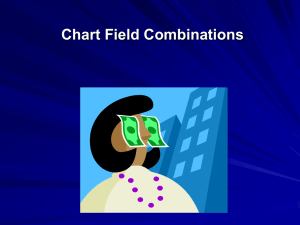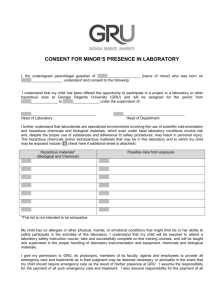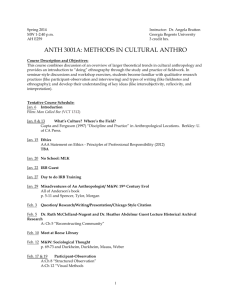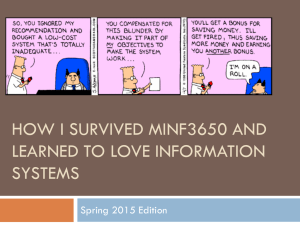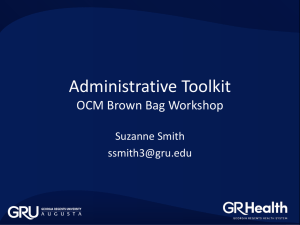Schedule of PSC Storm Hardening Activities and Deadlines
advertisement
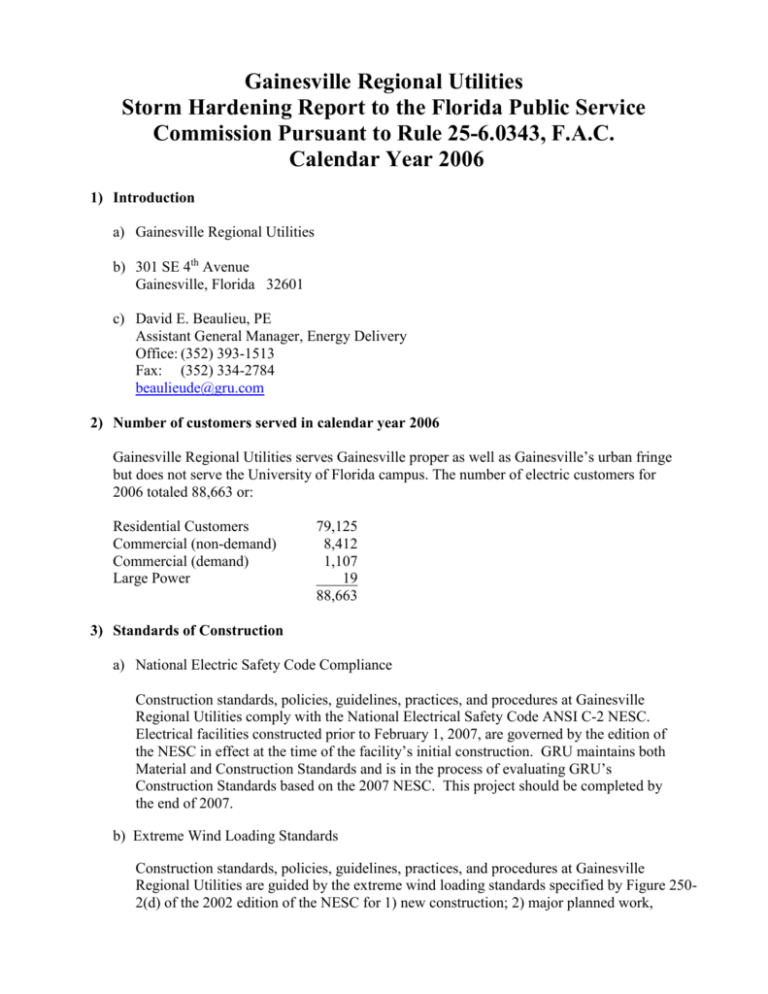
Gainesville Regional Utilities Storm Hardening Report to the Florida Public Service Commission Pursuant to Rule 25-6.0343, F.A.C. Calendar Year 2006 1) Introduction a) Gainesville Regional Utilities b) 301 SE 4th Avenue Gainesville, Florida 32601 c) David E. Beaulieu, PE Assistant General Manager, Energy Delivery Office: (352) 393-1513 Fax: (352) 334-2784 beaulieude@gru.com 2) Number of customers served in calendar year 2006 Gainesville Regional Utilities serves Gainesville proper as well as Gainesville’s urban fringe but does not serve the University of Florida campus. The number of electric customers for 2006 totaled 88,663 or: Residential Customers Commercial (non-demand) Commercial (demand) Large Power 79,125 8,412 1,107 19 88,663 3) Standards of Construction a) National Electric Safety Code Compliance Construction standards, policies, guidelines, practices, and procedures at Gainesville Regional Utilities comply with the National Electrical Safety Code ANSI C-2 NESC. Electrical facilities constructed prior to February 1, 2007, are governed by the edition of the NESC in effect at the time of the facility’s initial construction. GRU maintains both Material and Construction Standards and is in the process of evaluating GRU’s Construction Standards based on the 2007 NESC. This project should be completed by the end of 2007. b) Extreme Wind Loading Standards Construction standards, policies, guidelines, practices, and procedures at Gainesville Regional Utilities are guided by the extreme wind loading standards specified by Figure 2502(d) of the 2002 edition of the NESC for 1) new construction; 2) major planned work, Florida PSC Storm Hardening Report: Rule 25-6.0343 Page 2 including expansion, rebuild, or relocation of existing facilities, assigned on or after December 10, 2006; and 3) targeted critical infrastructure facilities and major thoroughfares. GRU maintains both Material and Construction Standards and is in the process of evaluating GRU’s Construction Standards based on the 2007 NESC for extreme wind conditions. This project should be completed by the end of 2007. c) Flooding and Storm Surges Electrical construction standards, policies, guidelines, practices, and procedures at Gainesville Regional Utilities address the effects of flooding but facilities are not generally subject to storm surges (saltwater intrusion) on underground distribution facilities and supporting overhead facilities. Gainesville Regional Utilities is located in north central Florida, roughly equidistant to both coasts, and has limited exposure to flooding. Where there has been significant flooding GRU evaluates the opportunity to move the facilities, underground or overhead, to a more secure positions. Gainesville Regional Utilities is also participating in the Public Utility Research Center’s (PURC) study on the conversion of overhead electric facilities to underground and the effectiveness of undergrounding facilities in preventing storm damage and outages through the Florida Municipal Electric Association. d) Safe and Efficient Access of New and Replacement Distribution Facilities Electrical construction standards, policies, guidelines, practices, and procedures at Gainesville Regional Utilities provide for placement of new and replacement distribution facilities so as to facilitate safe and efficient access for installation and maintenance. Gainesville Regional Utilities has developed a plan that prioritizes facilities that are to be replaced due to age and repeat outage occurrences. Wherever possible, difficult-to-access facilities are reviewed to determine if they can be relocated. GRU utilizes new poles and insulated aerial cable to harden the system. GRU also maintains back lot equipment that facilitates access and better response time to repair facilities. e) Attachments by Others Electrical construction standards, policies, guidelines, practices, and procedures at Gainesville Regional Utilities include written safety, pole reliability, pole loading capacity, and engineering standards and procedures for attachments by others to the utility’s electric transmission and distribution poles. Gainesville Regional Utilities requires third party pole attachment agreements, and within the agreement, the third party must submit a permit to GRU for approval. The permit must include information that an engineer has evaluated the impact of the pole attachments on the existing poles and that the proposed pole(s) meet NESC requirements. GRU will be evaluating the impact of communication utilities during the evaluation of design requirements based on the 2007 NESC. Florida PSC Storm Hardening Report: Rule 25-6.0343 Page 3 4. Facility Inspections a) Policies, guidelines, practices, and procedures for inspecting transmission and distribution lines, poles, and structures. GRU has had a comprehensive and periodic pole inspection/treatment program since 1992. Overview The inspection cycle has been established at eight (8) years. The inspection method is ‘sound and bore method’ for every pole and a complete visual inspection is also performed as well for cracks, splitting and obvious decay. The pole base is exposed (where possible) to 18 inches to inspect for indications of decay. Where not possible, pole is Mitc-fume. Mitc-fume is a pesticide that will migrate throughout the pole to prevent rot, decay and bug damage. Poles less than ten (10) years old are not inspected. Pole treatment is documented by Pole Inspection Program Maps. Transmission GRU visually inspects all transmission lines and poles twice each year and following major storm events. GRU has detailed inspection and ground line treatment performed on all wood transmission poles following an 8-year cycle. The inspection and treatment of these poles consists of a full visual inspection, and sound and boring to locate unseen decay pockets. Visual inspection includes below ground line inspection to a depth of 18” around the base of each pole. After inspection any decay is removed and a preservative paste is applied to prevent future decay. Transmission lines are also treated with MITC-fume to prevent internal decay as well. MITC-fume is a pesticide that migrates throughout a pole to prevent rot, decay and bug damage. Visual inspections also provide information about other items such as damaged hardware, woodpecker holes, cracks, splits and decayed pole tops. GRU replaces all rejected poles within one year of the inspection date. Rejected poles determined to be a “priority” are replaced immediately. Distribution GRU performs a detailed inspection and ground line treatment on wooden distribution poles over an 8-year cycle. All wood poles 10 years of age and older are inspected and treated over the cycle. The inspection and treatment of these poles consists of a full visual inspection, and sounding and boring to locate unseen decay pockets. Visual inspection includes below ground line inspection to a depth of 18” around the base of each pole. After inspection any decay is removed and a preservative paste is applied to prevent future decay. Distribution poles that can not be fully ground line inspected are treated with MITC-fume to prevent internal decay. Visual inspections also provide information on other problems such as damaged hardware, woodpecker holes, cracks, splits and decayed pole tops. GRU replaces all rejected poles within one year of the inspection date. Rejected poles determined to be a “priority” are replaced immediately. Florida PSC Storm Hardening Report: Rule 25-6.0343 Page 4 b) Number and percentage of transmission and distribution inspections planned and completed for 2006. GRU planned to inspect 32 transmission poles in 2006 and completed inspection on all of them (Inspection 100% completed). There were 3,068 distribution poles that met annual inspection criteria (10 years of age or older) and, therefore required inspection (Inspection 100% completed). c) Number and percentage of transmission poles and structures and distribution poles failing inspection and the reason for the failure. Of the 32 transmission poles inspected in 2006, 6 were replaced (failure percentage 18.8%). Of the 3,068 distribution poles inspected in 2006, 90 poles were replaced (failure percentage 2.9%). d) Number and percentage of transmission poles and structures and distribution poles, by pole type and class of structure, replaced or for which remediation was taken after inspection, including a description of the remediation taken. Gainesville Regional Utilities Pole Replacement Summary 2005 & 2006 Note: All distribution poles were replaced due to decay. Distribution 2005 2006 Replaced Poles Total Inspected 3,636 3,068 Height/Class 25/7 30/1 30/2 30/3 30/4 30/5 30/6 30/7 35/3 35/4 35/5 35/6 40/1 40/2 40/3 40/4 40/5 40/6 45/2 45/3 Rejected 130 90 2005 1 0 1 0 2 3 8 1 1 2 19 4 0 1 1 15 6 7 1 9 Replacement Percent 3.6% 2.9% 2006 0 3 0 1 0 6 13 0 6 5 16 1 2 0 1 10 3 0 2 4 Florida PSC Storm Hardening Report: Rule 25-6.0343 Replaced Poles (cont’d) 45/4 45/5 50/1 50/3 55/2 55/3 Page 5 40 1 0 4 1 2 11 2 1 2 0 1 Transmission Pole Replacement Summary 2005 & 2006 Transmission 2005 2006 Total Inspected 138 32 Rejected 3 6 Replacement Percent 2.2% 18.8% Note: All distribution poles were replaced due to woodpecker damage. 5. Vegetation Management a) Utility’s policies, guidelines, practices, and procedures for vegetation management, including programs addressing appropriate planting, landscaping, and problem tree removal practices for vegetation management outside of road right-of-ways or easements, and an explanation as to why the utility believes its vegetation management practices are sufficient. GRU’s Vegetation Management Department maintains approximately 600 miles of distribution lines on a three year rotating cycle. Scheduling of work is accomplished according to defined electrical distribution circuits. Maintenance trimming is also accomplished by circuit. GRU circuits range in size from approximately two to twenty five miles in length. Prioritizing of these circuits is based upon reliability, customer requests and visual inspections. We are completing our 5th maintenance cycle. The Vegetation Management Program includes maintenance of primary, secondary and service drops. We also have an aggressive herbicide program to reduce the density of undesirable vegetation as well as a tree growth regulator program to address specific problems. As much as it is possible to identify potentially hazardous trees from beyond the limits of the right-ofway/easement, we have had a program to negotiate with the property owner to remove these trees and provide the owner with a voucher redeemable for low growing species if need be. The distribution vegetation maintenance program is based upon nationally recognized standards of tree care and vegetation management practices and adapted to Gainesville's environment and specific operating concerns. These standards and practices include, but are not limited to the following: National Electric Safety Code Florida PSC Storm Hardening Report: Rule 25-6.0343 ANSI A300 (Tree care - standard practices) ANSI Z133.1 (Tree care - safety practices) Shigo - Pruning trees near electrical utility lines Shigo - Tree Pruning Matheny and Clark - Evaluation of hazardous trees in urban areas Page 6 Components of the distribution maintenance program are: Routine utility tree pruning Selective tree removals based upon hazardous conditions Selective use of herbicides Selective use of tree growth regulators Wood chip recycling Appropriate planting GRU has produced a “Plant the Right Tree in the Right Place” brochure with a list of compatible tree species. By compatible we mean that these species may be planted within ten feet of an overhead power line. The mature height of these species is such that they should never reach GRU facilities. GRU maintains a number of different types of ground level electric facilities. The two that we are concerned with are switch gear and pad-mount transformers. It is imperative that customer do not plant shrubs and small trees directly in front of these facilities. Each structure has a decal that reflects the above recommendations. We have also developed a set of tree planting guidelines for use by developers and engineers as to appropriate species to be planted within prescribed distances from our facilities. The City of Gainesville enjoys an especially dense tree canopy, one that is clearly favored by our community and its citizens. As a neighbor and responsive municipal electric utility, GRU has long acknowledged our obligation to serve our customers in this environment in the most effective yet least intrusive manner. Consequently, GRU is among those Florida utilities with the highest ratio of underground to overhead facilities. Our Vegetation Management program was developed over time with a care and control agenda that has been recognized as a model program for electric utilities. GRU records and continually monitors vegetation related service interruptions. Preventable tree outages make up only 1% or less of the total outages experienced system wide. GRU Florida PSC Storm Hardening Report: Rule 25-6.0343 Page 7 observed a 30% drop in vegetation related circuit trips for 2005 which continued for 2006. Tree preventable outages for 2005 and 2006 were: Tree Preventable Outages 2005 = 0.06% Tree Preventable Outages 2006 = 1% Transmission Program Gainesville Regional Utilities was the subject of a North American Electric Reliability Council (NERC) performance and readiness audit in April 2006 where GRU’s Vegetation Management Program received a Potential Example of Excellence (PEOE). Their report stated “GRU has a well documented and comprehensive vegetation management policy, program and knowledgeable staff. The GRU vegetationmanagement program and staff oversight is identified as a potential example of excellence for its comprehensive, detailed procedures and performance of the program itself.” b) Quantity, level, and scope of vegetation management planned and completed for transmission and distribution facilities. GRU’s Transmission and distribution right-of way maintenance of vegetation is a routine and on-going, year round program accomplished through a utility approved contractor directed and supervised and by GRU Forestry professionals and Utility management staff. All current plans and trim time-lines are on schedule. Transmission System Information 240.4 circuit miles @138 kV 2.5 circuit miles @ 230kV (falls into NERC Standard FAC-003-1) GRU applies NERC Guideline FAC-003-1 over our entire transmission system. GRU’s transmission inspection program is based on a six-year cycle. The program calls for semi-annual inspections (spring and fall) to identify conditions which would pose a near-term threat to the operation of the system such as insect infestations or any other factor that would impact tree mortality or structural integrity. The program also calls for a complete inspection immediately following any significant events such as hurricanes, tornadoes or fires. Inspections cover 100% of the transmission system and are conducted by GRU foresters. Inspection Summary Spring 2006 - March 13 – 17, 2006 Inspected 100% of Transmission system. Results: Discovered 21 dead pines outside GRU right-of-way, informed owners of hazards and negotiated removal. Follow-up activities: April 10 – 11, 2006: Removed dead pines Inspection Summary Fall 2006 - September 12, 2006 and October 9 – 30 Inspected 100% of Transmission system. Results: No problems observed. Florida PSC Storm Hardening Report: Rule 25-6.0343 Page 8 Follow-up activities: None needed. Transmission work 2006 In 2006, GRU performed routine maintenance activities on its transmission system including mechanical trimming, cutting and danger tree removals. The entire floor of the transmission system was maintained by scheduled herbicide application (six-year cycle). GRU’s herbicide application program is selective and targeted only those species which were capable of growing to a mature height that would interfere with the conductors. Low growing species, except for the access areas, were not discouraged from growing. GRU also purchased and cleared additional easement rights where right of way width was inadequate. Distribution work 2006 GRU adhered to its three-year maintenance cycle and trimmed approximately 175 circuit miles that included 21 different circuits in 2006. 6. Storm Hardening Research Gainesville Regional Utilities is a member of the Florida Municipal Electric Association (FMEA), which is participating with all of Florida’s electric utilities in storm hardening research through the Public Utility Research Center at the University of Florida. Under separate cover, FMEA is providing the FPSC with a report of research activities. For further information, contact Barry Moline, Executive Director, FMEA, 850-224-3314, ext. 1, or bmoline@publicpower.com.
